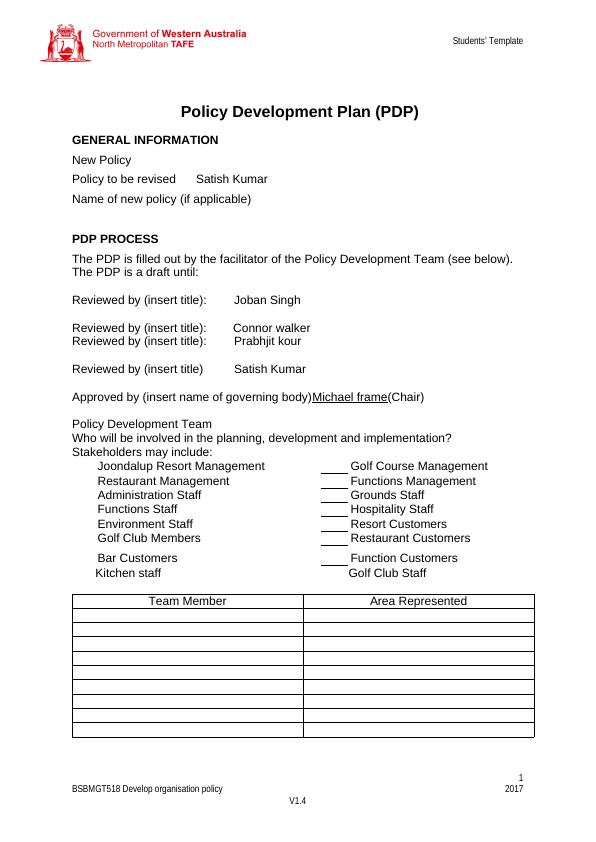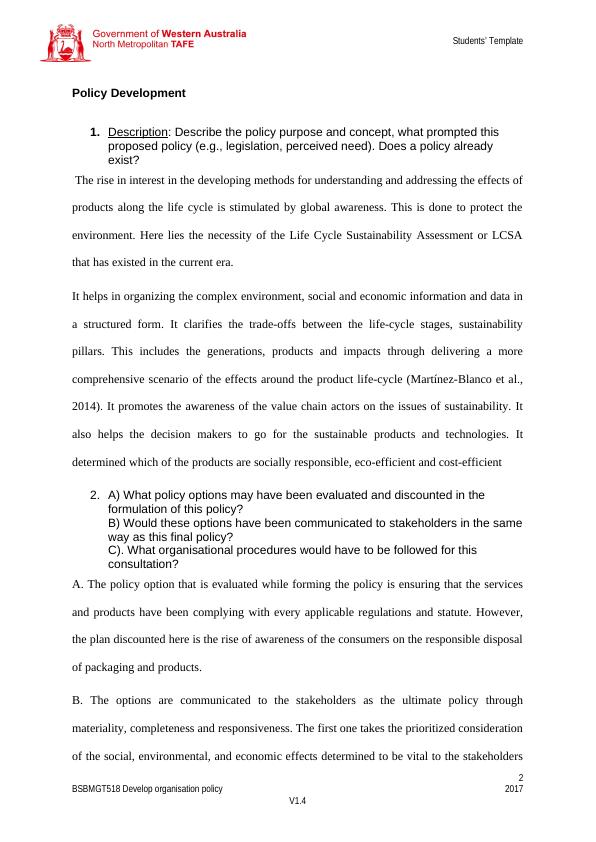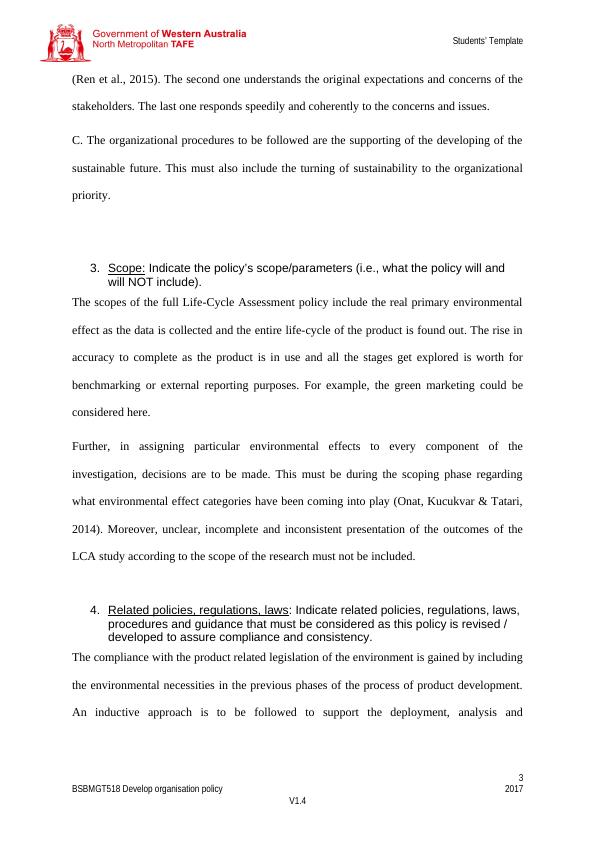Ask a question from expert
The Scopes of the Full Life Cycle Assessment
16 Pages3303 Words138 Views
Added on 2020-04-21
The Scopes of the Full Life Cycle Assessment
Added on 2020-04-21
BookmarkShareRelated Documents
Students’ Template Policy Development Plan (PDP)GENERAL INFORMATIONNew PolicyPolicy to be revised Satish KumarName of new policy (if applicable)PDP PROCESSThe PDP is filled out by the facilitator of the Policy Development Team (see below). The PDP is a draft until:Reviewed by (insert title):Joban SinghReviewed by (insert title): Connor walkerReviewed by (insert title):Prabhjit kourReviewed by (insert title)Satish KumarApproved by (insert name of governing body)Michael frame(Chair)Policy Development TeamWho will be involved in the planning, development and implementation?Stakeholders may include:Joondalup Resort ManagementGolf Course ManagementRestaurant ManagementFunctions ManagementAdministration StaffGrounds StaffFunctions StaffHospitality StaffEnvironment StaffResort CustomersGolf Club MembersRestaurant CustomersBar CustomersFunction Customers Kitchen staffGolf Club StaffTeam MemberArea Represented1BSBMGT518 Develop organisation policy2017V1.4

Students’ TemplatePolicy Development1.Description: Describe the policy purpose and concept, what prompted this proposed policy (e.g., legislation, perceived need). Does a policy already exist? The rise in interest in the developing methods for understanding and addressing the effects ofproducts along the life cycle is stimulated by global awareness. This is done to protect theenvironment. Here lies the necessity of the Life Cycle Sustainability Assessment or LCSAthat has existed in the current era. It helps in organizing the complex environment, social and economic information and data ina structured form. It clarifies the trade-offs between the life-cycle stages, sustainabilitypillars. This includes the generations, products and impacts through delivering a morecomprehensive scenario of the effects around the product life-cycle (Martínez-Blanco et al.,2014). It promotes the awareness of the value chain actors on the issues of sustainability. Italso helps the decision makers to go for the sustainable products and technologies. Itdetermined which of the products are socially responsible, eco-efficient and cost-efficient2.A) What policy options may have been evaluated and discounted in the formulation of this policy?B) Would these options have been communicated to stakeholders in the sameway as this final policy?C). What organisational procedures would have to be followed for this consultation?A. The policy option that is evaluated while forming the policy is ensuring that the servicesand products have been complying with every applicable regulations and statute. However,the plan discounted here is the rise of awareness of the consumers on the responsible disposalof packaging and products. B. The options are communicated to the stakeholders as the ultimate policy throughmateriality, completeness and responsiveness. The first one takes the prioritized considerationof the social, environmental, and economic effects determined to be vital to the stakeholders2BSBMGT518 Develop organisation policy2017V1.4

Students’ Template(Ren et al., 2015). The second one understands the original expectations and concerns of thestakeholders. The last one responds speedily and coherently to the concerns and issues. C. The organizational procedures to be followed are the supporting of the developing of thesustainable future. This must also include the turning of sustainability to the organizationalpriority. 3.Scope: Indicate the policy’s scope/parameters (i.e., what the policy will and will NOT include).The scopes of the full Life-Cycle Assessment policy include the real primary environmentaleffect as the data is collected and the entire life-cycle of the product is found out. The rise inaccuracy to complete as the product is in use and all the stages get explored is worth forbenchmarking or external reporting purposes. For example, the green marketing could beconsidered here. Further, in assigning particular environmental effects to every component of theinvestigation, decisions are to be made. This must be during the scoping phase regardingwhat environmental effect categories have been coming into play (Onat, Kucukvar & Tatari,2014). Moreover, unclear, incomplete and inconsistent presentation of the outcomes of theLCA study according to the scope of the research must not be included. 4.Related policies, regulations, laws: Indicate related policies, regulations, laws,procedures and guidance that must be considered as this policy is revised / developed to assure compliance and consistency.The compliance with the product related legislation of the environment is gained by includingthe environmental necessities in the previous phases of the process of product development.An inductive approach is to be followed to support the deployment, analysis and3BSBMGT518 Develop organisation policy2017V1.4

Students’ Templateidentification of the product necessities by environmental legislation by-products (Sala,Farioli & Zamagni, 2013). The first regulation must include the recognition of the legislation related to theenvironmental product. It includes the selecting of the sources of the trends and legislationsand the relevant legislations. Then the potential legal issues are to be identified. Here theassessment of the related topics and legislations are to be done along with the extraction ofthe traceability. Lastly, the product requirements are to be deployed. This must include thecategorization of the legislation and define the necessities. 5.Identify and mitigate (control) risks that may be associated with the introduction of this policy. Please use the accompanying Risk Assessment Log for more detailed analysis.The first risk is that the LCA accuracy and thoroughness has been depending on theavailability of data. The collection of data is challenging. The traditional LCA neverdetermines what technology, process and product are the top-performing and cost-effective. Unlike the conventional risk assessment, LCA never tries to quantify theparticular actual effects (Sonnemann et al., 2015). For mitigating the risks, the relation to the EPA statures is required typically. Theexercise of the discretion is needed in sustainability. Further, queries must be doneregarding the maximizing the economic and environmental benefits along withminimizing the harm. There must be multi-program and multidisciplinary teams to beappointed for more collaboration outside the local, state and federal agencies. Therelationship among the stakeholders must be made potentially more collaborative. 6.Stakeholders: Indicate when stakeholders will be consulted with during the policy creation process.There will be four phases of the process; initial (conception and planning), intermediate (development), final (close of 4BSBMGT518 Develop organisation policy2017V1.4

End of preview
Want to access all the pages? Upload your documents or become a member.
Related Documents
Policy Development Plan - PDFlg...
|13
|3215
|49
Agency Information Collection Activitieslg...
|17
|3560
|18